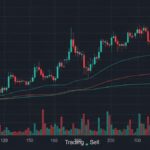High-frequency trading (HFT) relies on rapid data processing and visualisation to enable traders to make split-second decisions in financial markets. JavaScript Charts play a big role in this domain, providing dynamic, real-time visualisations that help traders interpret complex datasets efficiently. The ability to render large volumes of data with minimal latency is essential for HFT, where milliseconds can determine profitability. This article explores five essential chart types for high-frequency trading, their applications, and the technical considerations for implementing them using JavaScript charting libraries. These charts are selected for their ability to handle real-time data, offer analytical depth, and support the fast-paced demands of HFT environments.
A developer from SciChart, a provider of high-performance charting solutions, offers the following insight: “For high-frequency trading, the choice of chart library is paramount to ensure low-latency rendering and robust technical analysis tools. Our JavaScript charting library supports advanced features like real-time data updates and over 40 chart types, enabling traders to visualise market movements with precision and speed.” This perspective underscores the importance of selecting a library tailored to the unique demands of HFT.
Candlestick Charts: The Backbone of Price Analysis
Candlestick charts are a cornerstone of financial trading, particularly in high-frequency environments where price movements occur rapidly. These charts display price data over a specific time interval, showing the open, high, low, and close prices for each period. Each candlestick represents a single time unit, with the body indicating the open and close prices and the wicks showing the high and low. In HFT, candlestick charts are valued for their ability to convey price trends and volatility in a compact, visually intuitive format.
The strength of candlestick charts lies in their capacity to reveal patterns such as doji, hammer, or engulfing formations, which traders use to predict short-term price movements. For HFT, where trades are executed in fractions of a second, these charts must update in real time without lag. JavaScript charting libraries like TradingView and Highcharts Stock excel at rendering candlestick charts with smooth animations and real-time data feeds. These libraries leverage WebGL or SVG rendering to ensure high performance, critical for handling the large datasets typical in HFT.
Implementing candlestick charts requires careful consideration of data granularity. In HFT, data points may be generated every millisecond, necessitating libraries that can handle millions of data points without performance degradation. Libraries such as LightningChart JS Trader are designed specifically for financial applications, offering features like custom candlestick rendering and integration with market data feeds. Traders can also overlay technical indicators, such as moving averages or Bollinger Bands, to enhance analysis directly on the chart.
Volume-Weighted Average Price (VWAP) Charts: Gauging Market Sentiment
Volume-weighted average price (VWAP) charts are essential for HFT traders seeking to assess market sentiment and execute trades at optimal prices. VWAP represents the average price of an asset, weighted by trading volume, over a specified period. This chart type is particularly useful in HFT because it provides a benchmark for evaluating whether a trade is executed at a favourable price relative to the market’s average.
In a VWAP chart, the price line is plotted alongside volume data, often displayed as a histogram at the base of the chart. This dual representation allows traders to correlate price movements with trading activity, identifying periods of high liquidity or potential reversals. For example, a price moving significantly above or below the VWAP may indicate overbought or oversold conditions, prompting rapid trading decisions.
JavaScript Charts like those offered by AnyChart or ChartIQ support VWAP calculations and real-time updates, enabling traders to monitor this metric dynamically. These libraries provide APIs to connect to live market data feeds, ensuring that VWAP values reflect the latest transactions. For HFT, the ability to recalculate VWAP in real time is critical, as delays can lead to missed opportunities. Libraries with GPU-accelerated rendering, such as LightningChart JS, are particularly effective for this purpose, as they can process and display large datasets with minimal latency.
Traders implementing VWAP charts must ensure their data pipeline is robust, as inaccuracies in volume or price data can skew calculations. Additionally, the chart should support interactive features like zooming and panning to allow traders to focus on specific timeframes, such as intraday price movements. These features enhance the usability of VWAP charts in the fast-paced HFT environment.
Order Book Heatmaps: Visualising Market Depth
Order book heatmaps are a powerful tool for HFT traders, providing a visual representation of market depth by displaying buy and sell orders at various price levels. Unlike traditional charts that focus on historical price data, heatmaps highlight the current state of the order book, showing the density of bids and asks. This information is critical in HFT, where understanding liquidity and potential price movements can inform trading strategies.
In an order book heatmap, price levels are plotted on the vertical axis, with colour intensity representing the volume of orders at each level. Green typically indicates buy orders, while red signifies sell orders, allowing traders to quickly identify areas of support or resistance. For example, a dense cluster of buy orders at a specific price level may suggest strong support, influencing a trader’s decision to enter a position.
JavaScript charting libraries like SciChart and Barchart Solutions offer advanced heatmap implementations tailored for financial applications. These libraries support real-time data streaming, ensuring that the heatmap reflects the latest order book updates. WebGL-based rendering is particularly effective for heatmaps, as it enables smooth transitions and high-performance visualisation of large datasets.
Implementing order book heatmaps requires integration with a broker’s API to access real-time order book data. Traders must also consider the granularity of price levels displayed, as overly fine-grained data can overwhelm the visualisation, while coarse data may obscure critical details. Libraries that support dynamic scaling and filtering, such as TradingView’s Lightweight Charts, allow traders to adjust the heatmap’s resolution to suit their needs.
Point and Figure Charts: Filtering Market Noise
Point and Figure (P&F) charts are a specialised chart type used in HFT to filter out market noise and focus on significant price movements. Unlike time-based charts, P&F charts plot price changes based on predefined increments, ignoring minor fluctuations. This approach is particularly valuable in HFT, where rapid price changes can obscure meaningful trends.
In a P&F chart, price movements are represented by columns of Xs (indicating rising prices) and Os (indicating falling prices). Each X or O corresponds to a fixed price increment, and a new column is created when the price reverses by a specified amount. This method simplifies the visualisation of trends and reversals, making it easier for traders to identify key support and resistance levels.
JavaScript Charts like those provided by Highcharts Stock and JSCharting support P&F charting with built-in features for customising box sizes and reversal thresholds. These libraries allow traders to integrate P&F charts with real-time data feeds, ensuring that the chart reflects the latest market conditions. For HFT, the ability to update P&F charts in real time is essential, as delays can lead to outdated signals.
One challenge in implementing P&F charts is determining the appropriate box size and reversal threshold for the asset being traded. Highly volatile assets may require larger box sizes to filter out noise effectively, while less volatile assets may benefit from smaller increments. Libraries that offer programmatic control over these parameters, such as LightningChart JS Trader, enable traders to fine-tune their P&F charts for optimal performance in HFT.
Tick Charts: Capturing Market Activity
Tick charts are designed to visualise market activity based on the number of trades rather than time intervals. Each data point on a tick chart represents a fixed number of transactions, making it ideal for HFT environments where trade frequency varies significantly. By focusing on trade volume rather than time, tick charts provide a clearer view of market momentum and activity bursts.
In a tick chart, price movements are plotted as a series of bars or candlesticks, with each representing a set number of trades (e.g., 100 or 1000 trades). This approach allows traders to analyse market behaviour during periods of high activity, such as news releases or market openings, without the distortion of time-based intervals. For example, a sudden spike in trading volume can be immediately visible on a tick chart, prompting rapid decision-making.
JavaScript charting libraries like DXcharts and amCharts support tick chart implementations with real-time data updates. These libraries provide APIs to connect to tick-level data feeds, ensuring that the chart reflects the latest market activity. For HFT, the ability to handle high-frequency tick data without performance bottlenecks is critical. Libraries with WebGL acceleration are well-suited for this task, as they can render millions of data points efficiently.
Implementing tick charts requires careful consideration of the tick size, as a smaller tick size may result in excessive noise, while a larger size may obscure short-term trends. Traders must also ensure that their data feed provides reliable tick-level data, as inaccuracies can compromise the chart’s effectiveness. Libraries that support custom data aggregation, such as ChartIQ, allow traders to adjust tick sizes dynamically to balance detail and clarity.
Technical Considerations for HFT Charting
Implementing high-frequency trading charts using JavaScript requires careful attention to performance, data handling, and interactivity. HFT environments generate vast amounts of data, often in the range of millions of data points per second. Charting libraries must leverage hardware acceleration, such as WebGL, to render these datasets without lag. Libraries like LightningChart JS and SciChart use GPU-accelerated rendering to achieve high refresh rates and smooth interactions, even with constantly changing data streams.
Data integration is another critical factor. HFT charts require seamless connectivity to real-time market data feeds, typically through APIs or WebSocket connections. Libraries like TradingView and Highcharts Stock provide robust APIs for integrating with broker backends, ensuring that charts reflect the latest market conditions. Traders must also consider data preprocessing, such as filtering or aggregating tick data, to optimise performance without sacrificing accuracy.
Interactivity is essential for HFT charts, as traders need to zoom, pan, and annotate charts in real time. Libraries like ChartIQ and Barchart Solutions offer advanced interactive features, such as pinch-to-zoom and annotation toolbars, that enhance usability. Accessibility is also a consideration, particularly for platforms targeting a broad audience. Libraries like Highcharts include accessibility modules to ensure charts are usable by traders with disabilities, complying with standards like Section 508.
Choosing the Right JavaScript Charting Library
Selecting a JavaScript charting library for HFT depends on the specific requirements of the trading platform. Libraries like TradingView and LightningChart JS Trader are tailored for financial applications, offering specialised chart types and technical indicators. TradingView’s Lightweight Charts, for example, are optimised for minimal file size and high performance, making them ideal for embedding in web-based trading platforms. LightningChart JS Trader, on the other hand, excels at handling large datasets and provides over 100 technical indicators, catering to advanced HFT strategies.
For traders using React, libraries like Recharts and react-google-charts offer seamless integration with React applications. These libraries provide a balance of ease of use and customisation, though they may lack the advanced financial charting features of dedicated solutions like Highcharts Stock. For developers seeking maximum flexibility, D3.js allows for fully custom chart implementations but requires significant coding effort, making it less suitable for rapid deployment in HFT.
Cost is another consideration, as some libraries, such as Highcharts and ChartIQ, require paid licences for commercial use, while others, like ApexCharts and TradingView’s Lightweight Charts, are free or open-source. Developers must weigh the trade-offs between cost, performance, and feature set when selecting a library for HFT applications.
Future Trends in HFT Charting
As HFT continues to evolve, so do the demands on JavaScript Charts. Emerging trends include the integration of artificial intelligence for predictive analytics, enabling charts to highlight potential trading opportunities based on machine learning models.
Another trend is the increasing use of mobile and cross-platform charting solutions. With traders accessing markets from smartphones and tablets, libraries must support responsive designs and touch-based interactions. Libraries like Barchart Solutions and AnyChart are investing in mobile-friendly charting, ensuring that HFT charts perform consistently across devices.
Finally, the rise of decentralised finance (DeFi) and cryptocurrency trading is driving demand for specialised charting solutions. Libraries like DXcharts and JSCharting are adapting to support crypto-specific chart types, such as candlestick charts for token pairs, and real-time data feeds from blockchain networks.
Conclusion
High-frequency trading demands charting solutions that combine performance, interactivity, and analytical depth. Candlestick charts, VWAP charts, order book heatmaps, Point and Figure charts, and tick charts are among the most effective tools for visualising market data in real time. JavaScript charting libraries like SciChart, TradingView, and LightningChart JS Trader provide the technical capabilities needed to implement these charts, offering features like WebGL rendering, real-time data updates, and extensive customisation options. By selecting the right chart type and library, traders can gain a competitive edge in the fast-paced world of HFT, making informed decisions that capitalise on fleeting market opportunities.
Word count: 2004











